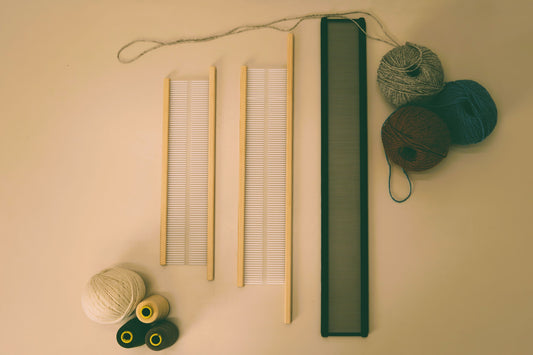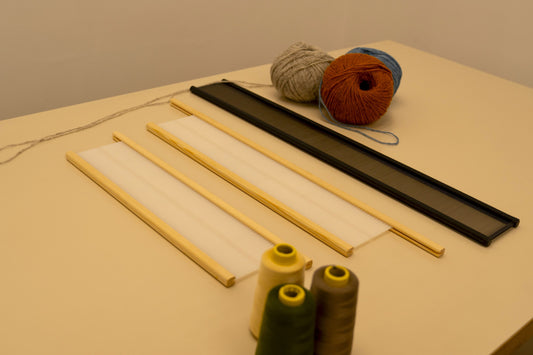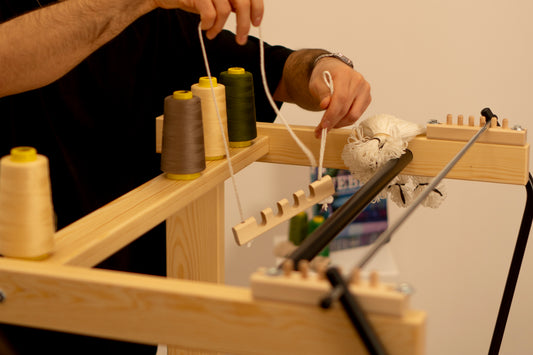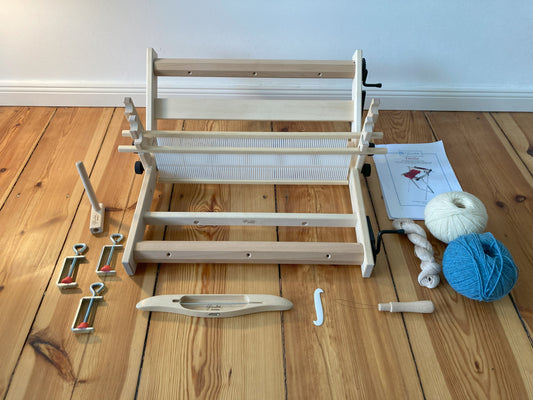To know

Weaving looms in comparison: The 5 best weaving...
Weaving is becoming increasingly popular—and rightly so! It's creative, calming, and offers endless possibilities. But before you start weaving, there's an important question: Which loom is right for me? Or...
Weaving looms in comparison: The 5 best weaving...
Weaving is becoming increasingly popular—and rightly so! It's creative, calming, and offers endless possibilities. But before you start weaving, there's an important question: Which loom is right for me? Or...

Weaving made easy: Translations of technical te...
Since many technical terms in weaving come from English or are used synonymously in the international community, we have started to collect and translate the most important terms for you.
Weaving made easy: Translations of technical te...
Since many technical terms in weaving come from English or are used synonymously in the international community, we have started to collect and translate the most important terms for you.

Weaving reed: wood or metal? A guide for hobby ...
As a hobby weaver or semi-professional hand weaver, you may be wondering which material is best for your reed. Here is a brief overview of the advantages and disadvantages of Wood...
Weaving reed: wood or metal? A guide for hobby ...
As a hobby weaver or semi-professional hand weaver, you may be wondering which material is best for your reed. Here is a brief overview of the advantages and disadvantages of Wood...

Short & Sweet: Understanding weaving combs ...
Choosing the right weaving comb: How to achieve the perfect density for your weave When it comes to weaving, the weaving comb is an essential tool that is often underestimated....
Short & Sweet: Understanding weaving combs ...
Choosing the right weaving comb: How to achieve the perfect density for your weave When it comes to weaving, the weaving comb is an essential tool that is often underestimated....

What is the difference between the different As...
Many weaving beginners ask themselves this question. Ashford is one of the leading manufacturers, alongside Glimåkra, with three potential loom models to choose from. We would like to offer you...
What is the difference between the different As...
Many weaving beginners ask themselves this question. Ashford is one of the leading manufacturers, alongside Glimåkra, with three potential loom models to choose from. We would like to offer you...

Glimåkra Emilia weaving loom - assembly instruc...
Congratulations on purchasing your Glimåkra Emilia weaving loom , one of the most beautiful weaving looms on the market. We at Berliner Webstuhl Manufaktur would like to thank you for...
Glimåkra Emilia weaving loom - assembly instruc...
Congratulations on purchasing your Glimåkra Emilia weaving loom , one of the most beautiful weaving looms on the market. We at Berliner Webstuhl Manufaktur would like to thank you for...
Frequently Asked Questions
How much does a weaving loom cost?
The cost of a weaving loom can vary depending on the type, size, quality and function. Typically, weaving looms are much cheaper than looms and are therefore often used by beginners or children. Simple weaving looms are usually available from around 30 euros, such as this handmade weaving loom . Advanced weaving looms can cost up to 400 euros. These weaving looms also have special functions or weaving widths of up to 70 cm, such as the Glimåkra Susanna weaving loom .
How does a weight loom work?
Weight looms are attached to the floor and wall or ceiling. The warp threads are attached to the moving warp beam at the top and tensioned at the bottom with weaving weights, which give the loom its name. Weaving is done from top to bottom. A weaving comb weaves the warp threads together at the ends, if necessary, for clean selvedges.
Weaving weights have been documented in Europe since around 6000 BC. Even weights are important to ensure even tension on the warp threads. For uneven weights, stones should be balanced and an appropriate number of warp threads should be attached.
Weight looms originally had limited weaving sizes due to the reach of human arms. The largest surviving piece, a Danish coat, measures 2.35 m x 1.30 m.
What is a countermarch loom?
A counter march loom is a loom that uses a special device to suspend the shafts to facilitate weaving. Unlike the more primitive method using rockers, where two shafts are always lowered or raised at the same time, the counter march loom allows for better shedding because both the shafts being raised and those being lowered are connected. This requires not only treadle mechanisms, but also crossbars to control each shaft individually. These crossbars are located at different levels and make it easier to link the shafts to the treadles.
The roller-pulley loom uses metal rollers, unlike wooden rockers. There are different ways of implementing the lacing and lifting and lowering mechanisms, and it is advisable to do your research before deciding to buy such a loom.
Is weaving difficult?
Weaving can be somewhat challenging at first, especially if you are new to textiles. However, the difficulty depends on a number of factors, including the desired weaving pattern, the type of loom, and your own skills. With practice and guidance, weaving can be learned relatively quickly, and many people find it an extremely satisfying craft. Since there are different levels of difficulty in weaving, depending on the patterns chosen, both beginners and advanced weavers can find their own way. Beginner courses are available in most major cities. If you don't have a weaving course nearby, you can now find various online tutorials on YouTube.
